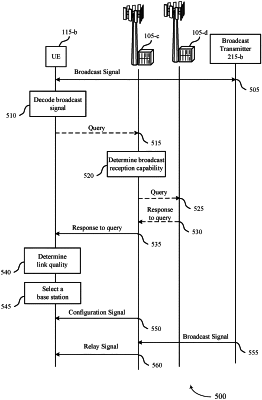| CPC H04W 8/245 (2013.01) [H04W 24/08 (2013.01); H04W 28/0268 (2013.01); H04W 48/10 (2013.01); H04W 48/20 (2013.01); H04W 72/0446 (2013.01); H04W 72/30 (2023.01)] | 41 Claims |

|
1. An apparatus for wireless communication at a user equipment (UE), comprising:
one or more memories; and
one or more processors coupled with the one or more memories and configured to cause the UE to:
receive, from a broadcast transmitter, a first broadcast signal comprising one or more multi-resolution messages, the one or more multi-resolution messages comprising at least a first message having a first resolution and a second message having a second resolution different from the first resolution;
decode the first message, the second message, or both;
select a network entity for reception and relay of a second broadcast signal from the broadcast transmitter based at least in part on whether the first message, the second message, or both are decoded and based on a broadcast reception capability of the network entity;
receive a configuration signal that indicates a transmission mode of the network entity;
monitor at least a portion of a time slot for reception of a relay signal based at least in part on the transmission mode of the network entity, wherein the relay signal comprises a relay of the second broadcast signal; and
receive the relay signal from the network entity based at least in part on the portion of the time slot that is monitored.
|